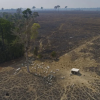The global community is struggling to reduce greenhouse gas emissions, and the world is on a trajectory to surpass the temperature limits set by the 2015 Paris Agreement. Global temperatures have already risen by 1.3°C relative to preindustrial levels, and they are expected to exceed the Paris goal of limiting warming to 1.5°C by as soon as 2040. By the end of the century, temperatures could rise by as much as 3-4°C, which would have catastrophic consequences for the planet.
In response to this alarming situation, fringe ideas about artificially cooling the planet are gaining attention. One such idea is solar geoengineering, specifically a technique called stratospheric aerosol injection (SAI), which aims to cool the planet by reflecting sunlight.
Several major institutions, including the White House and the UN Intergovernmental Panel on Climate Change, are exploring this controversial idea as a potential temporary solution while emissions are reduced. However, California-based startup Make Sunsets has already begun testing this technology, launching balloons filled with sulfate particles into the atmosphere to reflect sunlight.
SAI is one of the cheapest and simplest geoengineering methods, which explains its growing appeal. However, it remains highly controversial, with several experiments being canceled due to public opposition. The UN Environment Assembly recently rejected a proposal to form a study group on solar geoengineering, highlighting the deep concerns surrounding this approach.

The controversy stems from the potential for SAI to disrupt global weather patterns and create unintended consequences. It could lead to regional droughts, floods, and food insecurity. Moreover, there is a lack of international law or governance to regulate SAI, raising fears that countries or nonstate actors might unilaterally engage in SAI without global consent. This could trigger armed conflict if nations perceive such actions as threats to their security.
Stronger international rules are urgently needed to govern SAI. While research on solar geoengineering should not be entirely prohibited, any future use of SAI must be collectively governed. Unilateral actions by individual countries or organizations could lead to global instability, making it essential that SAI is regulated under international agreements.
SAI is inspired by natural events like volcanic eruptions, which have temporarily cooled the planet. For example, the 1991 eruption of Mount Pinatubo lowered global temperatures by 0.5°C for over a year. Advocates of SAI argue that this cooling effect could be replicated deliberately by injecting sulfate particles into the atmosphere. Proponents see SAI as a potential way to buy time while transitioning to renewable energy sources.
However, large-scale SAI could have serious and unpredictable consequences, including disrupting global rainfall patterns, damaging the ozone layer, and threatening ecosystems. Worse, if SAI were abruptly stopped, it could lead to a rapid and dangerous warming effect known as “termination shock.” Additionally, reliance on SAI might undermine efforts to reduce greenhouse gas emissions, slowing progress on decarbonization.
The biggest risk of SAI is that it could be deployed unilaterally by governments, organizations, or even wealthy individuals without global consent. The low cost and technical feasibility of SAI make it a tempting option for quick climate fixes, but these actions could have far-reaching consequences, such as global food insecurity and weather disruption. Current international laws do not provide adequate regulation or governance of SAI, leaving the world vulnerable to unilateral actions.
There is an urgent need for international dialogue and new rules to govern SAI before it triggers geopolitical conflict. If a state perceives SAI efforts as a threat to its food or water security, it could justify military action. Historically, nations have gone to war over resource threats, and climate modification could become the next trigger. Several institutions, including the White House and IPCC, have warned of the risks of geopolitical instability caused by unilateral SAI.
A new international treaty is needed to prohibit the unauthorized deployment of SAI and establish a collective decision-making process for its use. This treaty should involve multilateral representation, particularly from countries most vulnerable to climate change. The agreement would also need to prevent nonstate actors from engaging in SAI and ensure that any deployment is done under international oversight.
Existing institutions, such as the Montreal Protocol or the UN Framework Convention on Climate Change, could serve as platforms for negotiating a treaty on SAI governance. Expanding these frameworks to include solar geoengineering would be more efficient than creating entirely new institutions. While the topic is controversial, major powers are increasingly open to discussing the governance of solar geoengineering.
As the climate crisis worsens, the temptation to deploy SAI will grow. Therefore, it is critical to establish strong governance mechanisms to regulate its use. International cooperation and oversight are essential to prevent the destabilization of global climate patterns and the potential for conflict. A robust governance regime can help ensure that solar geoengineering, if ever deployed, is done responsibly and collectively, rather than through reckless and unilateral actions.

